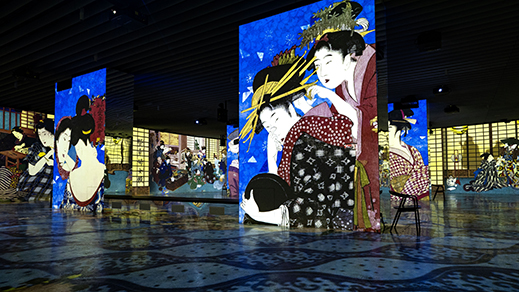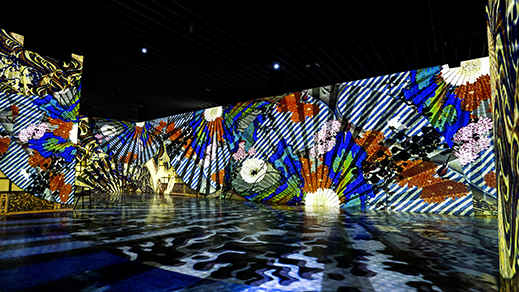| |
|
Here and There introduces art, artists, galleries, museums, and other cultural facilities around Japan that non-Japanese readers and first-time visitors may find of particular interest.
|
|
 |
|
|
 |
 |
Digitizing the Floating World: An Immersive Ukiyo-e Experience
Alan Gleason |
 |
Cherry blossoms cover the walls and floor in one segment of the Spirit of Japan program. © Danny Rose Studio © Kadokawa Culture Museum |
The Kadokawa Culture Museum looms above the Tokyo suburb of Higashi-Tokorozawa, a massive, windowless, roughly cubic chunk of gray granite hard by a futuristic shopping center and a shiny new Shinto shrine that resembles a Starbucks. Designed by the ubiquitous Kengo Kuma and opened in 2020, the fortress-like structure is eye-catching, but hardly inviting. Nor is the layout inside terribly user-friendly. Exhibit spaces of various shapes and sizes fill its five stories, but overall the museum seems designed on the premise that making a public facility difficult to navigate enhances the visitor's excitement -- a theory all too frequently applied to commercial architecture in Japan these days. (For a detailed look at the museum and its architecture, see the October 2020 Focus.)
Or maybe I'm just getting old, and the youth of today love this sort of place? In any event my initial impression of the museum wasn't auspicious. It took a while to find my way to the object of my visit, an ambitious installation that promised a "unique, 360-degree whole-body experience" of animated ukiyo-e. By the time I entered the gallery I was in a curmudgeonly mood, ready to grumpily dismiss what sounded like a misguided idea -- digitizing and enlarging those classic pictures of the floating world by Hokusai, Utamaro, and the rest into bloated, weirdly animated images many times their true size. Still, I was curious to see if they could make it work.
The Kabuki segment of the Spirit of Japan program. © Danny Rose Studio © Kadokawa Culture Museum |
I was right in one respect: the animation is weird. But it is also startlingly beautiful, and it grows on you. The full program lasts 30 minutes, starting on the half hour and repeating without pauses. So when you walk into the vast (1,100 square meters!) darkened chamber and first encounter the installation, you might be anywhere in the cycle. The cacophony of images coursing across the walls and floor shifts from moment to moment. Kabuki actors, courtesans, warriors, ghosts, waves, fish, birds, cherry blossoms -- all come and go in bewildering succession.
 |
|
The Women segment of the Spirit of Japan program. © Danny Rose Studio © Kadokawa Culture Museum |
Though audience size is limited by a reservation system, you will be sharing the space with quite a crowd. Most people will be standing, though there are also benches to sit on, facing in various directions. It doesn't matter where you sit, since the images will swirl around you in 360 degrees, as promised. I recommend sitting through two or three cycles of the show. The first time through, you will merely be overwhelmed by the cascade of outsize ukiyo-e motifs. All will be familiar to fans of the Edo-era masters of the art, but not on this scale. By the second iteration you begin to discern some order in the deluge. There are a dozen chapters, each devoted to a particular ukiyo-e genre or element: landscapes, flowers, actors, women, and so on. Though the transition from section to section is seamless, the animation styles vary enough to suggest that each is the work of a different designer. You may also begin to notice that there is something rather un-Japanese about the way these motifs have been extracted and reassembled.
 |
|
The Fan segment of the Spirit of Japan program. © Danny Rose Studio © Kadokawa Culture Museum |
The creator of the show, which is titled Spirit of Japan: Ukiyo-e Theater from Paris, is Danny Rose Studio, a "multidisciplinary art and design collective creating and realizing large scale digital artworks." Based in France, it has a track record of producing award-winning multimedia installations in places as far-flung as Italy, Australia, and China, as well as at a couple of Olympics. Achieved by applying projection mapping technology to some 440 ukiyo-e prints, the Kadokawa show is an expansion of the studio's 2019 installation Dreamed Japan, Images of the Floating World, which was presented in Paris and Provence.
While it's hard to put my finger on it, Danny Rose's approach to dissecting and reconstructing ukiyo-e imagery does seem distinctly Western -- and not in a bad way! This is most evident in the parts of the show that highlight such elements as the sea, the sky, calligraphy, lanterns and fans, a refreshing departure from the usual classification of ukiyo-e by subject: landscapes (Hiroshige and Hokusai), beautiful women (the bijin-ga of Utamaro), warriors (musha-e), actors (yakusha-e) and so on. Of course, these more typical categories feature prominently as well.
 |
|
The Sea segment of the Spirit of Japan program. © Danny Rose Studio © Kadokawa Culture Museum |
Cranes take off during the Sky segment of the Spirit of Japan program. © Danny Rose Studio © Kadokawa Culture Museum |
Where the animators excel, however, is in their unorthodox choices and juxtapositions of familiar motifs. An opening sequence of pastoral Hokusai landscapes gives way to a profusion of folding fans that fill the space with a lovely kaleidoscopic geometry, followed by a bursting forth of cherry blossoms. A pine forest at night is gradually illuminated by the pulsing, glowing figures of foxes and rabbits who silently morph into humans, then back into animals. Multiple replications of Hokusai's Great Wave rise and crash across the walls to the sound of Debussy's La Mer; suddenly Kuniyoshi's giant whale appears riding the swells. A meditative white-on-black display of abstract calligraphy turns to clouds in the sky, which form the backdrop to a huge flock of cranes soaring in oblique formation. These unexpected transmutations give the show its momentum and charm, compensating for the more predictable segments featuring such ukiyo-e tropes as actors and courtesans.
 |
|
Calligraphy by the Zen priest Mumon Yamada in the Gesture segment of the Spirit of Japan program. © Danny Rose Studio © Kadokawa Culture Museum |
The Japanese Spirits segment of the Spirit of Japan program. © Danny Rose Studio © Kadokawa Culture Museum |
One of the least engaging sections, in fact, is one apparently intended to showcase the celebrated "beautiful women" of Utamaro. A disappointingly static scene of domestic life in a brothel, where the figures barely move (a hand repetitively stroking a shamisen here, a little girl bouncing a ball there), it would have benefited from a more enlivening style of animation. At the other extreme, bombastic visages of posturing Kabuki actors and battling samurai, accompanied by a soundtrack of vigorous taiko drumming, seem timed to serve as the show's climax, but their impact pales in comparison with the more lyrical sequences of blooming flowers, floating butterflies, and shape-shifting spirits in the forest.
The Landscapes segment of the Spirit of Japan program. © Danny Rose Studio © Kadokawa Culture Museum |
The final chapter, however, is sublime: a quiet tableau of paper lanterns, the sort carried by courtesans to navigate the streets of the pleasure quarters at night. Gently drifting across the walls, they resemble fireflies -- or the tiny candle-lit boats that people all over Japan set afloat on rivers during the summer Bon festival in memory of deceased loved ones. It's a poignant conclusion, one that soothes the soul after the half hour of relentless assault, however gorgeous, on one's senses.
The Lanterns segment of the Spirit of Japan program. © Danny Rose Studio © Kadokawa Culture Museum |
The still photos shown here hardly do justice to the Spirit of Japan experience, but you can get a little taste of it from videos such as this one on YouTube. If you plan to go, be sure to register online beforehand for a time slot. Visitors are allowed to stay up to two hours in the exhibition, which includes side displays ranging from original ukiyo-e prints to contemporary works featuring the likes of David Bowie and the rock band Kiss. The museum also offers numerous other entertainments, though it is annoyingly set up with separate admission fees for each gallery. If you want to make a day of it, advance purchase of the "KCM 1-Day Passport" is recommended.
All images are courtesy of the Kadokawa Culture Museum.
|
 |
| Spirit of Japan: Ukiyo-e Theater from Paris |
| 30 October 2021 - 8 May 2022 |
| Kadokawa Culture Museum |
3-31-3 Higashi-Tokorozawa Wada, Tokorozawa, Saitama
Open 10 a.m. to 6 p.m. (Sunday - Thursday), to 9 p.m. (Friday - Saturday); last admission 30 minutes before closing
Closed on the 1st, 3rd and 5th Tuesdays of the month, except national holidays (closed on the following day instead)
Admission by online reservation and advance ticket purchase only
Access: 10-minute walk from Higashi Tokorozawa Station on the JR Musashino Line
|
|
|
|
| |
 |
Alan Gleason
Alan Gleason is a translator, editor and writer based in Tokyo, where he has lived for over 30 years. Since 2006 he has edited artscape Japan and written the Here and There column, as well as translating the Picks reviews. He also edits and translates works on Japanese architecture, music, and theater. |
|
|
|
|
|
|
|
|
|
 |
|